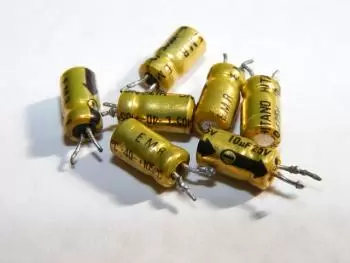
A capacitor is an electronic component that stores and releases electricity.
The physical quantity associated with a capacitor is the electrical capacity capacitance. Capacitance is a measure of the amount of charge the capacitor can store. It depends on the area of the plates, the spacing between them, and the type of insulating material used.
What is a capacitor?
A capacitor (or condenser) is a device that stores electrical energy in an electrical circuit and can be used in both direct and alternating currents (DC and AC).
Physically, this energy storage system is made up of two electrical conductors separated by a dielectric material.
The storage capacity depends on the surface of the plates that compose it, as well as the insulating material that is between these plates.
Capacitor banks are physical groups of capacitors that are connected in series or parallel with each other to store electrical energy.
Principle of capacitors: How do they work?
Capacitors are made up of two conducting plates separated by an insulator, and their operation is based on the ability of insulating materials to allow the passage of electric current.
A potential difference is produced between its ends when a capacitor is connected to a circuit. This is because the insulator does not allow the passage of electrons.
As a result, a parallel plate capacitor stores the charge on the plate closest to the negative charge. The sum of these charges explains the principle that generates an electric field inside the capacitor.
An electrical current flows between these plates when a voltage is applied, charging one plate with a positive charge and the other with an equal and opposite negative charge.
When the insulator can no longer sustain the number of charges, the electrons pass to the dielectric and the other plate, releasing them back into the circuit.
Capacitor Types
Below are some of the most common types of capacitors:
Electrolytic capacitors
Electrolytic capacitors are made of metal foil and an insulating membrane. They are immersed in an electrolyte solution, which allows the conduction of electricity.
These capacitors can store large amounts of charge and are used as voltage regulators and integrated circuits.
This type of electrical capacitor is divided into other subgroups, of which the most common are:
-
Tantalum capacitors are more resistant and durable than other dielectric materials.
-
Aluminum-Polypropylene Capacitors are composed of aluminum foil and a polymer insulator. They are used in laptops, cell phones, and electronic devices.
Ceramic capacitors
Ceramic capacitors are composed of two metal plates separated by a ceramic dielectric. Dielectric is a material that does not conduct electricity but allows the flow of the electric field. Due to their low capacitance, these capacitors are used to filter audio and video signals.
Polyester capacitors
They are made of a metallic layer and a dielectric, generally composed of plastic films. They are commonly used in electronic circuits to filter alternating electrical currents.
Paper capacitor
They are made from a rolled sheet of paper. They are submerged in a liquid, and the humidity nourishes the electricity, allowing a wide range of frequencies. These capacitors are inexpensive and easy to manufacture, so they are used in applications such as tuners, low-pass filters, and integrated circuits.
Plastic film capacitors
A metal layer and a plastic film dielectric form these capacitors. They are generally used in circuits where filtering and controlling high frequencies is necessary.
Applications of capacitors
Capacitors are devices used to store electrical energy and release it quickly. They generally control the amount of power that flows through a circuit.
Electrical capacitors are used in a variety of applications, from home electronics to power systems.
Some examples of its use are:
-
To provide a large amount of power in a very short space of time, such as when starting an engine or flashing a camera
-
To smooth out voltage fluctuation in certain electrical circuits as a power conditioning. A capacitor stores energy when the voltage is very high and releases it when it decreases. This property is used in power supplies to protect equipment from power surges.
-
It allows to generate of delays in the electronic circuits. Furthermore, the capacitor is very useful for tuning circuits generating tasks at regular periods by dealing with the charging time.
-
They can work as passive elements in radio frequency (RF) circuits.